
PRESERVATION CELEBRATION WINNERS
Take a look at 2024’s Preservation Award winners!
We celebrated these award winners at our annual Preservation Celebration on Thursday, September 19.


Take a look at 2024’s Preservation Award winners!
We celebrated these award winners at our annual Preservation Celebration on Thursday, September 19.


We proudly present “The Endangered Building People,” a short film that showcases the impactful work of Historic Seattle over the past five decades (1973-2023).
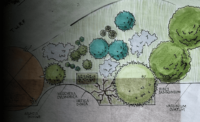
As a preservation organization it is Historic Seattle’s responsibility to bring awareness to the deepest and richest natural history of the Puget Sound area by highlighting the historic yet ongoing relationship between native plants and the First Peoples.

Historic Seattle is selling the Egan House.
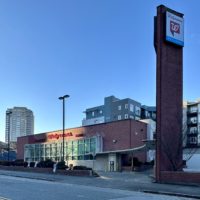
Preservation is a Public Benefit
In the past month and a half, preservation supporters in Seattle came together to advocate for maintaining the integrity of the landmark designation process. Since 1973, the City of Seattle has designated approximately 450 landmarks that are subject to protection by the Landmarks Preservation Ordinance (LPO). Ostensibly, the recent controversy revolved around the landmarked Seattle-First National Bank Building (SFNB), located at 566 Denny Way in Uptown, but it became much bigger than that one landmark.
Background
The Seattle-First National Bank Building was designated a Seattle landmark in 2006 under four (out of six) designation standards, a strong statement by the Landmarks Preservation Board (LPB) in recognizing the significance of the building. The exterior and the site were included in the designation. Walgreens purchased the property in 2007 (one year after the designation), adapted the former bank into a retail store, and worked with the Landmarks Preservation Board to reach a Controls and Incentives (C&I) agreement in November 2021 that would apply to the site and exterior of the building. (Controls help to protect a landmark and economic incentives can help an owner maintain a landmark.) The final step in the landmark designation process is City Council approval of the designating ordinance and adoption of the C&I agreement.
Because the SFNB is located in the Uptown neighborhood of Queen Anne, it is eligible as a landmark sending site for Transfer of Development Rights (TDR). This is an important financial incentive that became available for Uptown only in the last few years. The owner can sell TDRs and use the money to maintain the landmark building. A developer who owns a property in Uptown that qualifies as a receiving site can purchase the TDRs to benefit their housing project by increasing FAR (and therefore, additional units). This is a win-win for preservation AND housing. It’s both/and, not either/or.
The Issue
OK, great! So, what was the problem? On December 9, 2022, the City Council’s Neighborhoods, Education, Civil Rights, and Culture Committee met to review Council Bill 120312 (an ordinance relating to historic preservation; imposing controls upon the Seattle-First National Bank Building). At that meeting, four members of the Committee questioned why the Seattle-First National Bank Building was landmarked (they did not believe it was significant), wondered what public benefit the landmark offered, and cited the need for more housing in Uptown, a dense urban neighborhood. Essentially, the Committee believed this landmark was getting in the way of more housing and they wanted to dictate the use on this privately owned property. However, the LPO does not give the LPB nor the Council authority to control use in a landmark building or site. The property is not for sale and there are no redevelopment plans for the site. Uses other than housing are also allowed on the parcel.
The Council Committee recommended to the full City Council that they reject the designating ordinance. We saw this recommendation as a major threat to preservation in Seattle and the City’s preservation program. Removing C&I would leave the landmark vulnerable to demolition and set a bad precedent that could undermine the landmark designation process for any designated landmark that does not have controls and possibly any future designated landmarks.
The Call-to-Action
CB 120312 was scheduled for the January 3, 2023 City Council meeting and then postponed for another week to January 10, 2023. Historic Seattle, the Queen Anne Historical Society, West Seattle-based advocates, the Washington Trust for Historic Preservation, and many individuals jumped into action in December and January to urge Councilmembers to honor the Landmarks Preservation Ordinance and designation process by passing the designating ordinance and adopting controls and incentives for the Seattle-First National Bank Building. A key message was that preservation and housing are not mutually exclusive—this is a false choice. It’s both/and, not either/or. We also supported a compromise that would place no controls on the parking lot north of the landmark building—making it easier for potential development. Council Central Staff provided an analysis of housing development potential on the parcel. It turns out that retaining the landmark could potentially yield more housing units on the site by using a combination of incentives, bonuses, and creative design of new construction. Detractors argued the parking lot is too small for a high-rise. We beg to differ given the many examples of high-rise residential construction on smaller or similar-size lots in this city.
The road to the January 10 City Council meeting was a wild one! There were three amendments to the original bill. The Council realized it could not de-list or “unlandmark” the building so the designation would remain. It is the role of Council to adopt, modify, or reject controls and incentives for a landmark. The Walgreens lawyer suggested to Council that they pass the designating ordinance but remove controls and incentives. So it became the battle of the amendments. Amendment A (proposed by Councilmember Tammy Morales) was to pass the designating ordinance but place no controls and incentives on the building and site (worst-case scenario in our minds). Amendment B (proposed by Councilmember Lisa Herbold) was to pass the designating ordinance and place controls on the exterior of the building and specific character-defining features on the site, but remove controls on the parking lot. Amendment C (proposed by Councilmember Andrew Lewis) supported Amendment B but would also remove the character-defining features on the site, effectively placing controls on the building, the site between the building and Denny Way, and the site between the building and 6th Avenue N. Are you still with us? Crazy, we know!
Historic Seattle supported Amendment B. And ultimately, we supported Amendment C. The result was City Council voted 9-0 for Amendment C which places controls on the landmark building’s exterior and the portion of the site between the building and Denny Way and between the building and 6th Avenue North.
Ultimately, Historic Seattle is happy with the outcome because City Council’s unanimous vote confirmed the longstanding landmark designation process. The Council’s role is not to “rubber stamp” but to confirm and respect the process. Historic preservation is a public benefit in and of itself and should not be pitted against other public policies. Only 0.5% of parcels in Seattle are designated landmarks or in historic districts. That is a minuscule amount in the grand scheme of the built environment.
A big thank you to all who contacted City Councilmembers advocating for the preservation of this modern landmark and for respecting the designation process. Every communication in support was important. Your voices were heard! Council President Debora Juarez’s recent weekly newsletter shows that Council received 124 letters in support of CB 120312 and the compromise amendments and 32 letters in opposition—four times more in support! Finally, we thank City Council for its final decision and particularly Councilmembers Herbold and Lewis for seeking a compromise solution that supports preservation of the landmark and maximizes housing potential.
Learn more:
Materials related to CB 120312
Feliks Banel, KIRO Newsradio, “Preservation groups: Seattle City Council making mistake with historic bank.” Click here to read or listen to this story!
Emma Hinchliffe, Daily Journal of Commerce, “Compromise reached in debate over future of landmarked Uptown bank building.”

We need YOU to urge City Council to vote in favor of Amendment B, a pro-housing and pro-preservation resolution, to the Controls & Incentives (C&Is) agreement for the Seattle-First National Bank (SFNB)* building at tomorrow’s January 10 Council Meeting at 2:00 PM!
Click here to read all supporting documents for the SFNB bill (CB 120312), including Proposed Amendment B. Sponsored by Councilmember Lisa Herbold, the amendment aims to meet demands from Council for housing development on the site while protecting and preserving the designated landmark by adopting C&Is for the building only:
“This amendment would remove the surface parking area on the north side of the Seattle-First National Bank building from the designated features of the landmark. Development would be permitted on the parking area, but controls and incentives would continue to apply to the building on the site, the sign post, the drive-through area, and landscaping between the building and the street.”
NOW is the time to Tell the Council that a vote in favor of Amendment B honors the Landmarks ordinance and process by adopting C&Is for the Seattle-First National Bank building and maximizes housing development on the parking lot:
Questions? Contact Eugenia Woo, Historic Seattle’s Director of Preservation Services, at eugeniaw@historicseattle.org.
*ICYMI: The Seattle-First National Bank Building (SFNB), located at 566 Denny Way in Uptown was designated a Seattle landmark in 2006. Walgreens purchased it after the designation, adapted the former bank into a retail store, and worked with the Landmarks Preservation Board (LPB) to reach a Controls and Incentives (C&I) agreement (in November 2021) that would apply to the site and exterior of the building. The last step in the landmark designation process is City Council approval of the C&I agreement, but some members of City Council seem to believe that preservation and housing are mutually exclusive. This is a false choice. It’s both/and; not either/or.
If this amendment to the C&I agreement is not adopted, the landmark will be vulnerable to demolition, setting a dangerous precedent for ALL future and current Seattle Landmarks without controls and disregarding a tried and true program (Transfer Development Rights) that allows preservation to be an asset in creating more housing within Seattle.
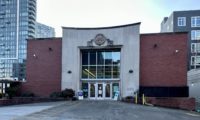
Feliks Banel with KIRO Newsradio has got it exactly right: Seattle City Council is making a mistake with the Seattle First National Bank Building (SFNB). Click here to read or listen to this story!
Having postponed the full council vote until Tuesday, January 10, City Council is still threatening Seattle’s robust landmarking process by not adopting already agreed upon Controls and Incentives (C&Is) for the SFNB. Instead, they may adopt an amendment, written up by the lawyers hired by Walgreens, to eliminate all controls and incentives. Some members of City Council seem to believe that preservation and housing are mutually exclusive. This is a false choice. It’s both/and; not either/or.
With the full council vote already delayed until January 10, NOW is the time to make your voice heard! Join us in telling the Council that denying C&Is for the SNFB:
A) sets a dangerous precedent for ALL future and current Seattle Landmarks without controls,
B) disregards a tried and true program (Transfer Development Rights) that allows preservation to be an asset in creating more housing within Seattle,
C) and insults our and your belief that preservation enriches the lives of all in Seattle.
AND, demand that City Council honor the Landmarks ordinance and process by adopting controls and incentives for the Seattle-First National Bank building.
Click here to review the 1/10/23 City Council Meeting Agenda, which includes three options to provide Public Comment to the Council:

Seattle City Council will vote in their January 3rd meeting (this coming Tuesday!) to adopt or deny Controls and Incentives (C&Is) for the Seattle First National Bank Building at 566 Denny Way in Uptown. A vote to reject these C&Is subjects this existing Seattle Landmark to NO protections and increases its vulnerability to demolition.
Join us in telling the Council that denying C&Is sets a dangerous precedent for ALL future and current Seattle Landmarks and demand that City Council honor the Landmarks ordinance and process by adopting controls and incentives for the Seattle-First National Bank building.
Click here to view the January 3, 2023 City Council Meeting Agenda, which includes the following options to provide Public Comment to the Council:
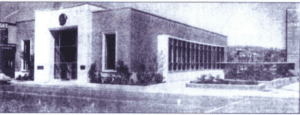
Seattle-First National Bank. Image credit: Construction News Bulletin, 1950.
Here’s the deal—we’re in a pickle: the Seattle-First National Bank Building (SFNB), located at 566 Denny Way in Uptown was designated a Seattle landmark in 2006. Walgreens purchased it after the designation, adapted the former bank into a retail store, and worked with the Landmarks Preservation Board (LPB) to reach a Controls and Incentives (C&I) agreement (in November 2021) that would apply to the site and exterior of the building. The last step in the landmark designation process is City Council approval of the C&I agreement, but we’re concerned Council may reject controls and incentives, thereby leaving the landmark vulnerable to demolition.
We need YOUR Help! Write to City Council before January 3 (ideally by December 23) and demand they honor the Landmarks ordinance and process by adopting controls and incentives for the Seattle-First National Bank building (reference CB 120312). A decision to reject controls and incentives for SFNB puts preservation and landmarking at risk! Contact all Councilmembers by emailing council@seattle.gov.
Context for said “pickle:” until recently, the SFNB has been declared as a building of significance (by virtue of its landmark designation), and a C&I agreement has been signed in which economic incentives are available to the property owner in exchange for committing to maintain the building.
You may recall from our ongoing Showbox advocacy efforts that landmark designation alone does not save buildings – controls and incentives are critical to protecting the places we love. The SFNB, having a designation and C&I agreement signed, means this building is well on its way to being preserved as an asset and public benefit to the City of Seattle. The final step is for the City Council to adopt Council Bill 120312.
OK, great! So, what’s the problem? On Friday, December 9, several members of the City Council’s Neighborhoods, Education, Civil Rights & Culture Committee met and challenged, without documentation or justification, the Seattle-First National Bank building’s landmark designation and the need to place controls and incentives on the building and site.
In advance of the meeting, Seattle City Council Central Staff provided the Committee with a 10-page memorandum detailing the landmarking process and recommendations for next steps. Additionally, the Committee received a joint letter of support for adopting controls and incentives for SFNB from Historic Seattle and the Queen Anne Historical Society.
The Council Committee’s recommendation to reject controls and incentives without reasons relevant to the Landmark Preservation Ordinance and in contradiction to the Landmarks Preservation Board (a group consisting of volunteers appointed by the Mayor and confirmed by City Council) is unprecedented and a major threat to preservation in Seattle and the City’s preservation program.
On Tuesday, January 3, 2023, Seattle City Council will decide whether to adopt the jointly agreed Controls and Incentives for the Seattle-First National Bank building. If rejected, the Council’s decision could undermine the landmark designation process for any designated landmark that doesn’t have controls and possibly any future designated landmarks.
This is NOT OK! Again, we urge you to write to City Council (council@seattle.gov) before January 3 (ideally by December 23) and demand they honor the Landmarks ordinance and process by adopting controls and incentives for the Seattle-First National Bank building (reference CB 120312).
Questions? Contact Eugenia Woo, Historic Seattle’s Director of Preservation Services, at eugeniaw@historicseattle.org.

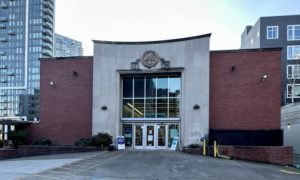
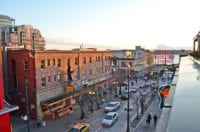
By Ruth Danner, President – Save the Market Entrance
The following is part of a series of guest blog posts submitted by members of the Historic Seattle community. The views and opinions expressed in guest posts are those of the authors and do not necessarily reflect the positions of Historic Seattle. As part of our mission, Historic Seattle is supporting Save the Market Entrance’s advocacy and communications work to landmark the Hahn Building.
With ground floor storefronts built in 1897 and two floors for workforce housing added in 1908, the Hahn Building/Hotel Elliott stands proudly at the southeast corner of Seattle’s intersection of First and Pike, at the main entrance to Pike Place Market. While Pike Place Market is a designated City of Seattle historic district (Pike Place Market Historical District) and listed in the National Register of Historic Places as the Pike Place Market Historic District, the historic buildings on the east side of First Avenue have been left to fend for themselves.
Its historic timeline goes back to the early 1880s arrival of Robert Hahn. In 1889, at the time of the Great Seattle Fire that devastated most of Pioneer Square, Hahn operated a wood-frame saloon and beer garden on this site. After the fire, it was said to be the last place standing for a man to buy a beer. Following the fire, wood structures were out and brick was in, and in 1897, Hahn built the structure under nomination as a one-story, brick building.
A decade later, two stories were added to the existing structure just as Seattle prepared for the Alaska-Yukon-Pacific Exposition in 1909. Those two new floors were dubbed Hotel Elliott, which provided private semi-permanent housing for Seattle’s growing workforce, one of the first single-room-occupancy (SRO) hotels to offer private baths with running hot and cold water. The Hahn Building/Hotel Elliott is prominently featured in historic photos of the Market Entrance across the decades. Along with the Hotel Elliott, the ground floor has retail has hosted a number of commercial ventures—from long-time tenant Owl Drugs to the infamous International Donut Shop.
In the massive reinvigoration on Pike Place Market in the 70s, blacktopping on Pike Place from Pike to Virginia was returned to its former bricked cobblestones out to and including the intersection at 1st and Pike that tied the four corners of the Market together. In 1981, the Hahn family, perhaps inspired by the market’s facelift and newly returning popularity undertook a beautiful, historically sensitive remodel. Identifying Hotel Elliott as affordable housing, the City of Seattle allocated $500,000 to reinforce the structure with seismic retrofitting. Hotel rooms continue to occupy the upper two floors operating as the Green Tortoise Hostel since 2005.
Twice since the current owners purchased the Hahn in 1986, they have presented the Landmarks Preservation Board with anti-nominations designed to argue against historic significance in an effort to clear the way for future demolition (in 1999 and again in 2014). But the five-year limit in the Landmark Preservation Ordinance that precludes another nomination to be considered has passed (as of December 2019), and the door is open for the public to argue their own case for the importance this building plays to our city and beyond.
The Hahn Building is not currently protected, and the current owner has plans to demolish the Hahn building and replace it with a 14-story boutique hotel. On December 2, at 3:30 pm the Landmarks Preservation Board will meet to consider our nomination, which we submitted in December 2019. We hired Katie Pratt and Spencer Howard of NW Vernacular Historic Preservation to dig a little deeper into the Hahn’s history and importance at this important intersection. What they found is compelling. Preservation of this building is essential to the symmetry and historical authenticity to this treasured four corner Market entrance and intersection.
We need your help! Please send written comments in support of landmarking to Sarah Sodt, the City of Seattle Historic Preservation Officer, via sarah.sodt@seattle.gov by or before Tuesday, December 1. Comments must relate to one or more of the six criteria for landmark nomination/designation. More information is available here.
Photo by Shree Ram Dahal